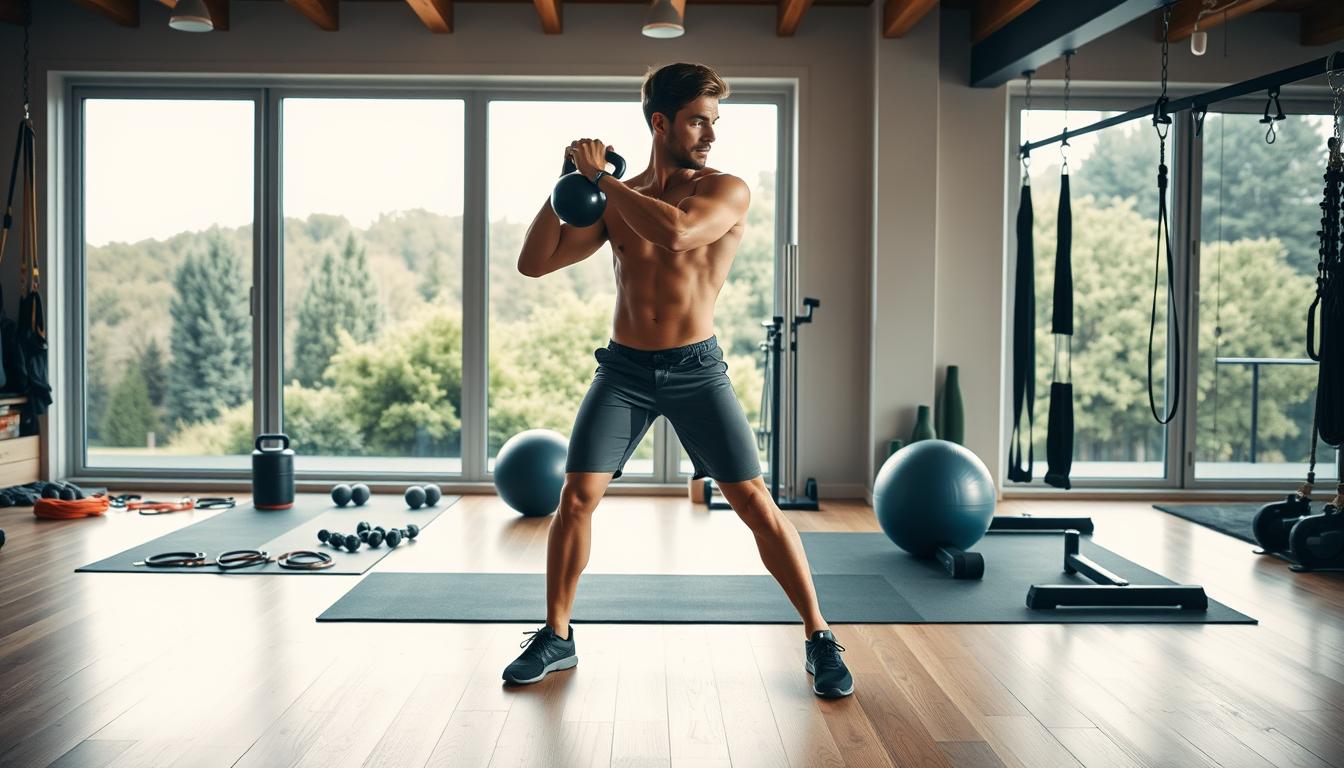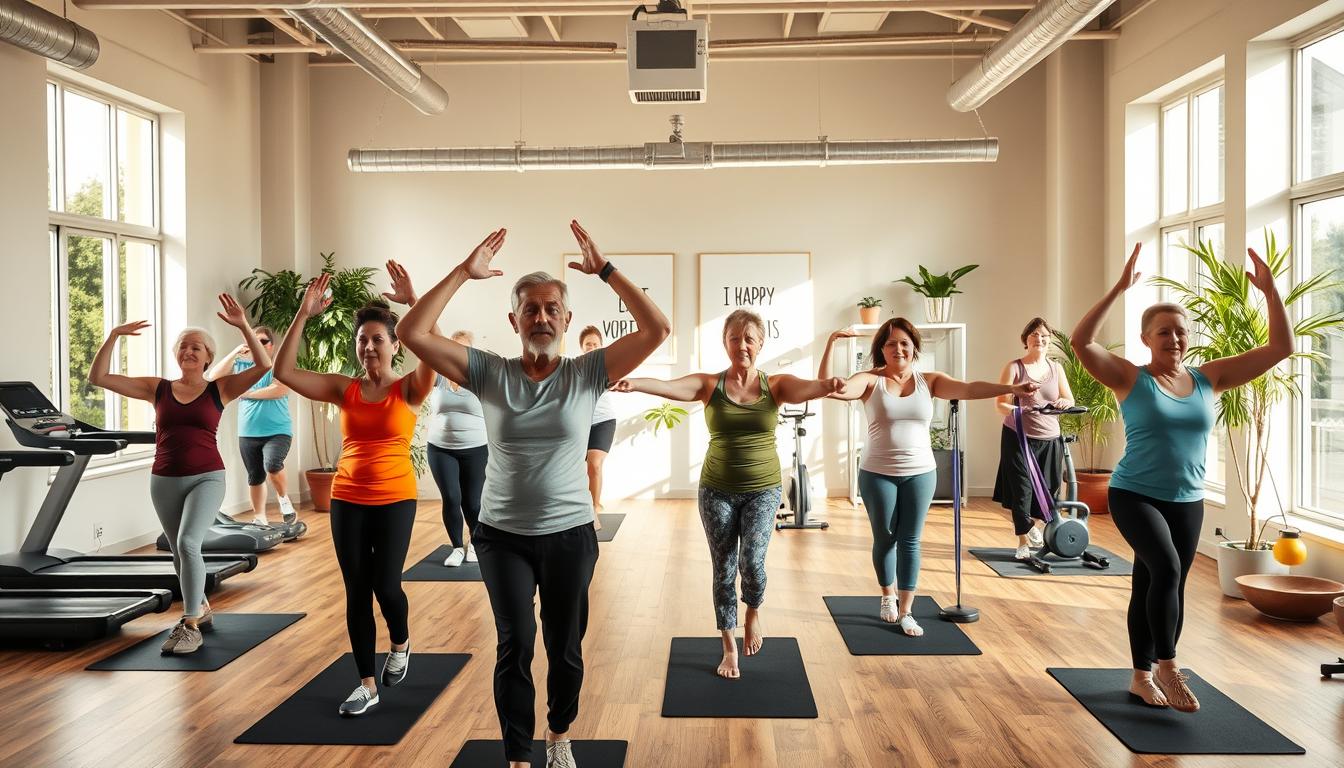Reflecting on functional fitness, I see it's not just about physical health. It's about embracing a lifestyle that boosts overall well-being. Exercises that enhance functional movement can greatly improve our quality of life and support healthy aging.
By adopting a holistic fitness mindset, we can keep our vitality high as we age. This approach is key to living a long, healthy life. As we get older, our bodies naturally change, impacting our mobility and independence.
Key Takeaways
- Functional fitness is crucial for maintaining vitality throughout life.
- Exercises that improve functional movement can enhance quality of life.
- A holistic fitness approach promotes overall well-being and healthy aging.
- Incorporating functional fitness can support independence as we age.
- A long and healthy life is achievable through a focus on functional fitness.
Understanding the Foundations of Functional Fitness
The concept of functional fitness is deeply rooted in training for everyday movements. It prepares our bodies for the demands of daily life, from carrying groceries to playing with children. This approach ensures we're ready for the real world.
What Makes Fitness "Functional"
Functional fitness exercises mirror real-world movements. These exercises engage multiple joints and muscle groups. This makes them highly effective for enhancing overall fitness.
Real-World Movement Patterns
Our daily lives involve movements like squatting, lifting, pushing, and pulling. These actions are crucial and performed in various settings.
Multi-Joint vs. Isolated Exercises
Multi-joint exercises, such as squats and deadlifts, engage multiple muscle groups at once. In contrast, isolated exercises, like bicep curls, target a single muscle. Functional fitness prioritizes multi-joint exercises.
| Exercise Type | Muscle Groups Involved | Functional Benefit |
| Squats | Legs, Glutes, Core | Improved mobility and strength for daily activities |
| Deadlifts | Back, Legs, Glutes, Core | Enhanced strength for lifting and carrying |
| Bicep Curls | Biceps | Limited functional benefit, primarily aesthetic |
The Evolution of Fitness Approaches
Fitness methods have evolved over time, with functional fitness becoming a key approach. This change highlights the growing recognition of practical, effective training methods.
Fit for Life: Functional Fitness for Longevity
Embracing functional fitness is a crucial strategy for boosting our longevity and enhancing life quality. This approach to exercise is essential for maintaining both physical and cognitive health as we age. It's vital for a healthy aging process.
The Science Behind Fitness and Aging
Research underscores the significant role of physical activity in aging. Studies on movement and lifespan emphasize the importance of regular exercise for healthy aging.
Research on Movement and Lifespan
Studies have explored the link between physical activity and longevity. They show that regular exercise can greatly impact our lifespan. For older adults, exercises that boost balance and strength are key to preventing falls and injuries.
How Functional Training Supports Longevity
Functional training enhances both physical and cognitive abilities, supporting longevity. It keeps individuals capable of performing daily tasks with ease. This form of exercise is vital for maintaining functional capacity.
Physical and Cognitive Benefits
The advantages of functional fitness are vast, including better physical function and cognitive health. By adding longevity exercises to our routine, we boost overall well-being. This promotes healthy aging.
Core Functional Movements for Lifelong Vitality
To achieve lifelong vitality, focusing on core functional movements is key. These movements form the basis of our daily activities, enabling us to live life fully.
Foundational Movement Patterns
Foundational movement patterns are basic movements our bodies are designed for. They include squats, hinge movements, push, and pull exercises. These are vital for everyday functionality.
Squats and Hinge Movements
Squats and hinge movements are essential exercises that work multiple muscle groups. Squats boost leg strength, while hinge movements, like deadlifts, enhance power and stability by targeting the posterior chain.
- Squats: Strengthens legs and glutes
- Hinge movements: Targets posterior chain
Push and Pull Exercises
Push exercises, such as push-ups, and pull exercises, like rows, are crucial for upper body strength and balance. They aid in performing daily tasks that involve pushing or pulling.
- Push-ups: Strengthens chest, shoulders, and triceps
- Rows: Targets back and arm muscles
Balance and Stability Exercises
Balance and stability exercises are vital for preventing falls and maintaining coordination. They improve proprioception and physical stability.
Mobility vs. Flexibility: Understanding the Difference
It's crucial to understand the difference between mobility and flexibility for a well-rounded fitness program. Mobility is the ability to move a joint through a range of motion. Flexibility is the ability to stretch a muscle. Both are essential for functional movement.
Incorporating these core functional movements into our fitness routine enhances sustainable fitness and long-term fitness goals. This leads to a more vital and healthy life.
Designing Your Functional Fitness Routine
Creating a personalized functional fitness routine starts with understanding your current abilities and setting achievable goals. Functional fitness goes beyond just working out. It's about improving your life quality and aging gracefully.
Assessing Your Current Functional Capacity
Before diving into a new fitness plan, it's vital to evaluate your current fitness level. This includes checking your strength, flexibility, balance, and endurance. You can do this by performing basic movements like squats, lunges, and balance tests.
Progressive Programming Strategies
After assessing your fitness, the next step is to develop a progressive workout plan. This means gradually increasing the intensity and complexity of your exercises. As fitness expert Gray Cook noted,
"The body will adapt to the demands you place on it."
Sample Weekly Routine
A weekly routine could include strength training, cardio, and flexibility exercises. For example:
- Monday: Squats and lunges
- Tuesday: Cardio such as jogging or cycling
- Wednesday: Rest day
- Thursday: Balance and stability exercises
- Friday: Upper body strength training
Adapting Exercises for Different Fitness Levels
It's important to adjust exercises based on your fitness level. Using modifications and progressions ensures your workouts stay challenging yet safe.
Modifications and Progressions
For beginners, start with modified squats or lunges to ease joint stress. As you get better, add weights or change the exercise to increase the challenge.
By following these steps and customizing your routine, you'll be on the path to fitness for longevity. This will help you stay independent as you age.
Functional Fitness Through Different Life Stages
Functional fitness is essential from young adulthood to our senior years. It enhances our quality of life. As we age, our fitness needs evolve. Functional fitness supports healthy aging and longevity exercises at every stage.
Early Adulthood: Building the Foundation
In early adulthood, we focus on building a strong foundation. Exercises that boost strength, flexibility, and coordination are key. This stage is critical for establishing sustainable fitness habits that endure.
- Engage in exercises that challenge your strength and endurance.
- Incorporate flexibility and mobility exercises to enhance range of motion.
Middle Age: Maintenance and Prevention
Middle age brings a shift to maintaining gains and preventing decline. We continue longevity exercises and adjust routines for emerging health concerns.
"Exercise is a celebration of what your body can do, not a punishment for what you ate." - Unknown
Senior Years: Preserving Independence
In our senior years, functional fitness is crucial for independence and fall prevention. Specific exercises enhance balance and strength.
Specific Exercises for Fall Prevention
Exercises like single-leg stands, heel-to-toe walks, and balance on unstable surfaces lower fall risks.
Functional fitness across life stages leads to a healthier, more independent life as we age.
Equipment and Tools for Functional Training
Functional fitness stands out because it doesn't require a lot of equipment. This makes it easy for people to fit into their busy lives. It's a flexible way to stay fit without a big investment.
Minimal Equipment Options
Functional training can be done with just a few pieces of equipment. One of the simplest ways is through bodyweight exercises.
Versatile Fitness Tools
For those who want to mix up their workouts, there are many versatile tools available.
Resistance Bands, Kettlebells, and Suspension Trainers
Resistance bands are light, easy to carry, and work out many muscle groups. Kettlebells are great for building strength and boosting heart health. Suspension trainers offer a bodyweight workout that adjusts to your fitness level.
| Equipment | Benefits |
| Resistance Bands | Portable, versatile, and suitable for all fitness levels |
| Kettlebells | Improves strength, cardiovascular fitness, and flexibility |
| Suspension Trainers | Adjustable resistance, works multiple muscle groups |
Creating a Functional Home Gym
To set up a home gym, first figure out the space you have and the exercises you want to do. A mix of bodyweight exercises and versatile tools can give you a full workout.
Using these tools and methods, you can keep up with functional training at home. It's a convenient way to stay fit and healthy.
Nutrition and Recovery for Sustainable Fitness
For long-term fitness success, balancing functional training with nutritional support and recovery is key. Sustainable fitness goes beyond regular exercise. It also involves nourishing your body and allowing it to recover.
Nutritional Support for Functional Training
A well-balanced diet is crucial for functional training. It should include protein, complex carbohydrates, and healthy fats. Adequate nutrition aids in muscle recovery, replenishes energy, and boosts performance.
Recovery Practices for Longevity
Recovery is vital in any fitness regimen. It's not just about rest. It also involves active recovery techniques like stretching, foam rolling, and light cardio.
Active Recovery Techniques
Effective active recovery techniques include:
- Stretching to improve flexibility
- Foam rolling to reduce muscle soreness
- Light cardio to enhance blood circulation
The Role of Sleep in Fitness Sustainability
Sleep is essential for fitness sustainability. It allows the body to repair and rebuild muscle tissue. Aim for 7-9 hours of quality sleep each night.
| Nutritional Element | Role in Fitness |
| Protein | Muscle repair and growth |
| Complex Carbohydrates | Energy replenishment |
| Healthy Fats | Overall health and hormone regulation |
Conclusion: Embracing Functional Fitness as a Lifestyle
Incorporating functional fitness into our daily lives can be a game-changer. It promotes longevity and overall well-being. Adopting a holistic fitness approach enhances our quality of life, ensuring independence and vitality as we age.
Functional fitness transcends being just a workout regimen; it's a lifestyle empowering us to live fully. By focusing on exercises that boost balance, mobility, and strength, we can tackle daily tasks with ease and confidence. This supports our health and well-being, leading to a life that is fit for longevity.
By making functional fitness a core part of our lifestyle, we can look forward to a healthier, more vibrant existence. I encourage you to start this journey. Embrace the principles of functional fitness to become a stronger, more resilient version of yourself.





Comments
Post a Comment